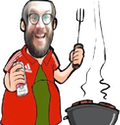The coyote (Canis latrans) is a species of canine native to North America. It is smaller than its close relative, the gray wolf, and slightly smaller than the closely related eastern wolf and red wolf. It fills much of the same ecological niche as the golden jackal does in Eurasia. The coyote is larger and was once referred to as the American jackal by a behavioral ecologist. Other historical names for the species include the prairie wolf and the brush wolf.
The coyote is listed as least concern by the International Union for Conservation of Nature, due to its wide distribution and abundance throughout North America. The species is versatile, able to adapt to and expand into environments modified by humans; urban coyotes are common in many cities. The coyote was sighted in eastern Panama (across the Panama Canal from their home range) for the first time in 2013.
The coyote has 19 recognized subspecies. The average male weighs 8 to 20 kg (18 to 44 lb) and the average female 7 to 18 kg (15 to 40 lb). Their fur color is predominantly light gray and red or fulvous interspersed with black and white, though it varies somewhat with geography. It is highly flexible in social organization, living either in a family unit or in loosely knit packs of unrelated individuals. Primarily carnivorous, its diet consists mainly of deer, rabbits, hares, rodents, birds, reptiles, amphibians, fish, and invertebrates, though it may also eat fruits and vegetables on occasion. Its characteristic vocalization is a howl made by solitary individuals. Humans are the coyote's greatest threat, followed by cougars and gray wolves. Despite predation by gray wolves, coyotes sometimes mate with them, and with eastern, or red wolves, producing "coywolf" hybrids. In the northeastern regions of North America, the eastern coyote (a larger subspecies, though still smaller than wolves) is the result of various historical and recent matings with various types of wolves. Genetic studies show that most North American wolves contain some level of coyote DNA.
The coyote is a prominent character in Native American folklore, mainly in Aridoamerica, usually depicted as a trickster that alternately assumes the form of an actual coyote or a man. As with other trickster figures, the coyote uses deception and humor to rebel against social conventions. The animal was especially respected in Mesoamerican cosmology as a symbol of military might. After the European colonization of the Americas, it was seen in Anglo-American culture as a cowardly and untrustworthy animal. Unlike wolves, which have seen their public image improve, attitudes towards the coyote remain largely negative.
Behavior
Like the Eurasian golden jackal, the coyote is gregarious, but not as dependent on conspecifics as more social canid species like wolves are. This is likely because the coyote is not a specialized hunter of large prey as the latter species is. The basic social unit of a coyote pack is a family containing a reproductive female. However, unrelated coyotes may join forces for companionship, or to bring down prey too large to attack singly. Such "nonfamily" packs are only temporary, and may consist of bachelor males, nonreproductive females and subadult young. Families are formed in midwinter, when females enter estrus. Pair bonding can occur 2–3 months before actual copulation takes place
When hunting large prey, the coyote often works in pairs or small groups. Success in killing large ungulates depends on factors such as snow depth and crust density. Younger animals usually avoid participating in such hunts, with the breeding pair typically doing most of the work. The coyote pursues large prey, typically hamstringing the animal, and subsequently then harassing it until the prey falls. Like other canids, the coyote caches excess food. Coyotes catch mouse-sized rodents by pouncing, whereas ground squirrels are chased. Although coyotes can live in large groups, small prey is typically caught singly
Habitat
Prior to the near extermination of wolves and cougars, the coyote was most numerous in grasslands inhabited by bison, pronghorn, elk, and other deer, doing particularly well in short-grass areas with prairie dogs, though it was just as much at home in semiarid areas with sagebrush and jackrabbits or in deserts inhabited by cactus, kangaroo rats, and rattlesnakes. As long as it was not in direct competition with the wolf, the coyote ranged from the Sonoran Desert to the alpine regions of adjoining mountains or the plains and mountainous areas of Alberta. With the extermination of the wolf, the coyote's range expanded to encompass broken forests from the tropics of Guatemala and the northern slope of Alaska.
Diet
The coyote is ecologically the North American equivalent of the Eurasian golden jackal. Likewise, the coyote is highly versatile in its choice of food, but is primarily carnivorous, with 90% of its diet consisting of meat. Prey species include bison (largely as carrion), white-tailed deer, mule deer, moose, elk, bighorn sheep, pronghorn, rabbits, hares, rodents, birds (especially galliformes, roadrunners, young water birds and pigeons and doves), amphibians (except toads), lizards, snakes, turtles and tortoises, fish, crustaceans, and insects. Coyotes may be picky over the prey they target, as animals such as shrews, moles, and brown rats do not occur in their diet in proportion to their numbers
In folklore and mythology
Coyote features as a trickster figure and skin-walker in the folktales of some Native Americans, notably several nations in the Southwestern and Plains regions, where he alternately assumes the form of an actual coyote or that of a man. As with other trickster figures, Coyote acts as a picaresque hero who rebels against social convention through deception and humor. Folklorists such as Harris believe coyotes came to be seen as tricksters due to the animal's intelligence and adaptability. After the European colonization of the Americas, Anglo-American depictions of Coyote are of a cowardly and untrustworthy animal
Prior to the Spanish conquest of the Aztec Empire, Coyote played a significant role in Mesoamerican cosmology. The coyote symbolized military might in Classic era Teotihuacan, with warriors dressing up in coyote costumes to call upon its predatory power. The species continued to be linked to Central Mexican warrior cults in the centuries leading up to the post-Classic Aztec rule.
Megathreads and spaces to hang out:
- 📀 Come listen to music and Watch movies with your fellow Hexbears nerd, in Cy.tube
- 🔥 Read and talk about a current topics in the News Megathread
- ⚔ Come talk in the New Weekly PoC thread
- ✨ Talk with fellow Trans comrades in the New Weekly Trans thread
reminders:
- 💚 You nerds can join specific comms to see posts about all sorts of topics
- 💙 Hexbear’s algorithm prioritizes comments over upbears
- 💜 Sorting by new you nerd
- 🌈 If you ever want to make your own megathread, you can reserve a spot here nerd
- 🐶 Join the unofficial Hexbear-adjacent Mastodon instance toots.matapacos.dog
Links To Resources (Aid and Theory):
Aid:
Theory:


Nerds in the news mega be like "ummm, ackshually, this is the wrong mega "
"
Oh, my bad. Did me talking about my gay fanfics interrupt your little play war room you fuckin nerds? 😤 🤓🤓🤓🙄
truly the fact that that mega is so much more active than the main one shows that the wisdom of the grillpill has not reached enough of the wayward souls of this world
nah, the general mega still gets more comments per day than the news mega if you count this and the last megathread its around 900 comments while the news mega sits at 600
me when any1 dare to fact check me --> >:^(
That's because I've been spamming apostles to convert people to the church of havana nother beer
Until a decade in a week happens, then where does that bring you? Back to us.
Leftists do be obsessed with politics
that obsession can be good if one is actually doing stuff in the real world but i think a lot of the spectacle obsession/doomscroll addiction/gaming out geopolitics hobbyism can be pretty misdirected and unhealthy IMO, one wld be better off using that energy writing a gay lil fanfic, painting a lil picture, writing a lil fiction, maybe even striking up a lil friendship in ur lil workplace with the fellow workers in ur own lil life (which can lead to oh shit, accidentally doing praxis). but i am a Christmanist about these things
Nah it means that we are cooler
"this is the wrong mega" well sometimes the "right" mega is 2+ days old and we don't want our incredibly interesting comments to be lost to time
just shamelessly repost at the start of the fresh one, ur thoughts are that valuable and insightful, trust. dont doubt urself, u r worth it
I want to see you talk about your gay fanfics. This made me snort.